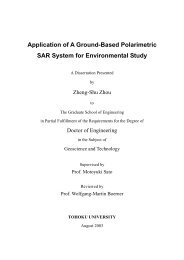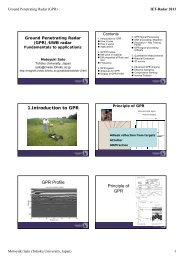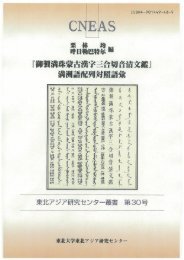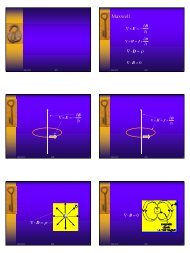Chapter 3: Vehicle-Mounted GPR System for Landmine Detection
Chapter 3: Vehicle-Mounted GPR System for Landmine Detection
Chapter 3: Vehicle-Mounted GPR System for Landmine Detection
Create successful ePaper yourself
Turn your PDF publications into a flip-book with our unique Google optimized e-Paper software.
3.5 Experimental Results 41<br />
could detect all of the objects including the stone on site.<br />
The quick detection algorithm is applied to this data. The window width w in Eq.<br />
3.11 has to be defined first from the wavelength. Fig. 3.17(a) shows traces at<br />
( x, y ) = (1050, 1000) mm (at Type72 buried), and (800, 1000) mm (at nothing<br />
buried). Since the semi-period seems 20 mm, the width w is defined as 20 mm. In<br />
these traces, the reflection from the target cannot be seen at the depth of the targets<br />
buried, 120 mm, since it is masked by the reflection from the ground surface.<br />
Whereas, it can be seen below a depth of 200 mm as a tail of the reflection. The<br />
envelope and moving averaged envelope of the traces are shown in Figs. 3.17(b) and<br />
(c). By moving average, the envelope is smoothened. Fig. 3.17(d) shows the<br />
normalized envelope. The tail of the reflection at a depth of 200 mm is enhanced.<br />
The histogram of the value pˆ( xy , ) in Eq. 3.13 is shown in Fig. 3.18. Here the<br />
thresholds to rate the confidence are simply defined as<br />
(a)<br />
(b)<br />
Fig. 3.12: <strong>Landmine</strong> models of Type72 (a), and PMN2 (b).








